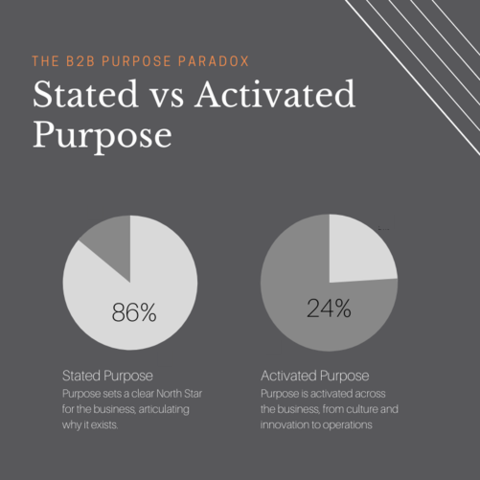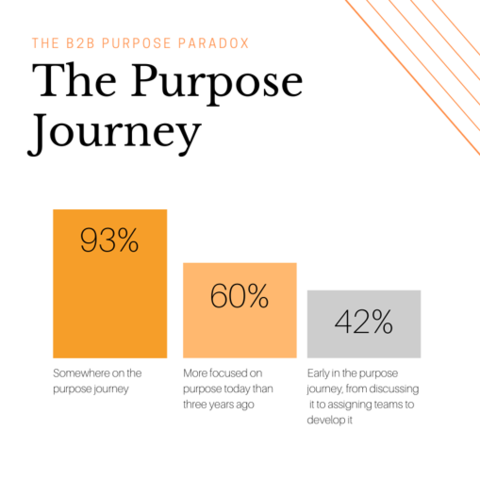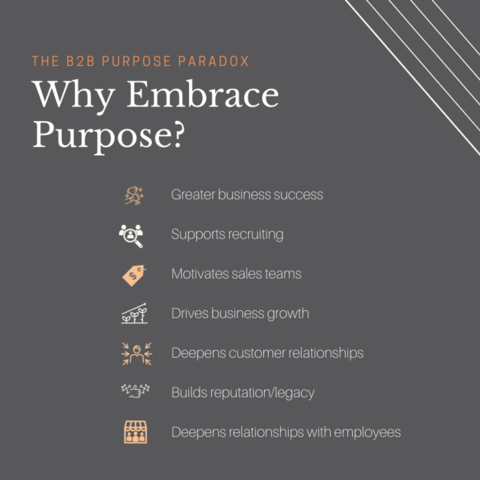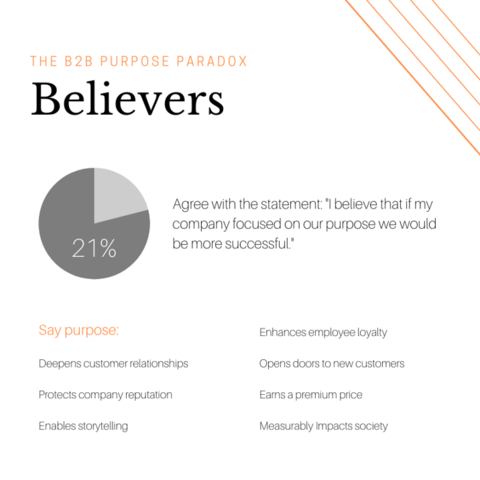- blog
- Corporate Social Responsibility
Long-considered a business-to-consumer (B2C) strategy, purpose is emerging as a critical differentiator among business-to-business (B2B) organizations. Eighty-six percent of B2B companies embrace purpose as an important “North Star” for the organization and growth driver, found The B2B Purpose Paradox Report.
The research explores an emerging gap between B2B organizations that understand and embrace purpose—86% of respondent companies—and those that have embedded and activated purpose to impact the business and society—24% of respondent companies. The report, developed in collaboration between the ANA, Carol Cone ON PURPOSE, and Harris Poll, defines purpose as “a company’s reason for being beyond profits that guides its business growth and impact on society.”
There is perhaps no better indicator of the legitimacy of purpose as a core business strategy than its growing prominence among B2B leaders. What we know as purpose today—heralded as critical to long-term business success by BlackRock chief Larry Fink, the Business Roundtable, and global thought leaders at Davos—started as philanthropy and corporate citizenship.
Those efforts, while important, remain divorced from core business operations. To be truly effective and sustained over time, purpose must be treated as core business strategy to influence culture, drive operations, ignite innovation and align key business objectives and competencies to engage with society.
There are growing audiences for B2B purpose, including:

The 86 percent of companies that embrace purpose have a Stated Purpose, or understanding of their reason for existing, beyond profits. Yet, only 24 percent have an Activated Purpose that is deeply embedded in the business to influence culture, operations, innovation, and engagement with society. The gap between identifying purpose and undertaking the work necessary to activate it fully within their organizations constitutes the purpose paradox.

B2B companies are still early in their purpose evolution, but momentum is accelerating. Ninety-three percent of companies are somewhere on the purpose journey, from developing teams to create purpose to fully integrating it in operations and into society. Sixty percent are more focused on purpose today than three years ago, and 42 percent report they are starting the purpose journey.
The financial and insurance industry leads in purpose, with 65 percent citing purpose as an important business strategy. Health care and allied industries, professional services, manufacturing, and technology and telecommunications follow.
The top reason B2B companies embrace purpose is a belief that they will achieve greater success than companies without purpose. Additional impacts include supporting recruiting efforts, motivating sales teams, demonstrating values in action, driving business growth, and deepening customer relationships.

Why aren’t B2B companies activating purpose? Fifty-six percent said purpose feels more like a PR exercise than a business strategy, and 51 percent say purpose isn’t significant among their competitive set. Another 50 percent say their organization lacks the capacity to integrate purpose.

The report uncovered a segment of employee ambassadors, called Believers, who agree with the statement: “I believe that if my company focused on our purpose, we would be more successful.” Twenty-one percent of respondents classify as Believers, while 34 percent are considered “Doubters,” who strongly disagree with the same statement.
Eighty-four percent of Believers agree their company’s purpose helps them earn a premium price. And among B2B employees who make purchase decisions on behalf of their companies, Believers are more likely to purchase from other purpose-driven organizations (90%) and are willing to pay more for their products (95%).
B2B organizations seeking to activate purpose would do well to identify and engage their Believers. These employees have greater pride in their organizations, are more willing to recruit others to the company, will defend the company in times of crisis, are more connected within the organization, and are more likely to provide excellent customer service.
In B2B organizations, purpose is more often positioned to drive vision and growth over the long-term, reflected in the sense of ownership by the C-suite. Nearly half of respondents said purpose is driven by their C-suite and implemented by other functions across the organization.
Senior leadership is vocal about purpose: 82 percent of leaders talk to employees about their organization’s purpose beyond profits, and 76 percent talk to external stakeholders about purpose. Across the organization, employees are considered the #1 stakeholder to engage via purpose, and 81 percent played a role in defining their organization’s purpose.
Advancing from a Stated Purpose to an Activated Purpose takes time, care, and commitment. Wherever a company lives on its journey, it should consider the following principles to ensure its purpose is authentic, long-lasting, and built to perform:
Download The B2B Purpose Paradox report for more insights on the paradox and principles to develop a high-impact purpose.